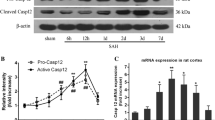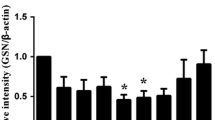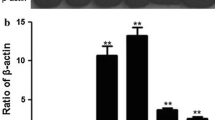Abstract
This study investigated the possible involvement of matrix metalloproteinase 9 (MMP-9) in early brain injury (EBI) of subarachnoid hemorrhage (SAH) in rats. MMP-9 activities in hippocampus were examined at 6, 12, 24, 48 and 72 h after SAH. Laminin was detected by immunohistochemistry. Apoptosis of neurons in hippocampus was observed by TUNEL. Brain water content was also examined. MMP-9 activity and the number of apoptotic neurons increased from 12 to 72 h with a peak at 24 h. Laminin was found to decrease at 12 h, reached minimum at 24 h and began to increase from 48 h, which had a negative correlation with apoptotic neurons. The changes of brain water content were found to be coincidence with that of neuronal apoptosis. Our findings suggest that MMP-9 is probably involved in the pathophysiological events of EBI after SAH, through degrading laminin which leads to neuronal anoikis of hippocampus.




Similar content being viewed by others
References
Bederson JB, Germano IM, Guarino L (1995) Cortical blood flow and cerebral perfusion pressure in a new noncraniotomy model of subarachnoid hemorrhage in the rat. Stroke 26:1086–1091
Bazan NG, Rodriguez de Turco EB (1980) Membrane lipids in the pathogenesis of brain edema: phospholipids and arachidonic acid, the earliest membrane components changed at the onset of ischemia. Adv Neurol 28:197–205
Park S, Yamaguchi M, Zhou C et al (2004) Neurovascular protection reduces early brain injury after subarachnoid hemorrhage. Stroke 35:2412–2417
Gu Z, Cui J, Brown S et al (2005) A highly specific inhibitor of matrix metalloproteinase-9 rescues laminin from proteolysis and neurons from apoptosis in transient focal cerebral ischemia. J Neurosci 25:6401–6408
Prunell GF, Mathiesen T, Diemer NH et al (2003) Experimental subarachnoid hemorrhage: subarachnoid blood volume, mortality rate, neuronal death, cerebral blood flow, and perfusion pressure in three different rat models. Neurosurgery 52:165–175
Xi G, Hua Y, Keep RF et al (2002) Brain edema after intracerebral hemorrhage: the effects of systemic complement depletion. Acta Neurochir Suppl 81:253–256
Macdonald RL, Curry DJ, Aihara Y et al (2004) Magnesium and experimental vasospasm. J Neurosurg 100:106–110
Zhou C, Yamaguchi M, Colohan AR et al (2005) Role of p53 and apoptosis in cerebral vasospasm after experimental subarachnoid hemorrhage. J Cereb Blood Flow Metab 25:572–582
Muroi C, Frei K, El Beltagy M et al (2008) Combined therapeutic hypothermia and barbiturate coma reduces interleukin-6 in the cerebrospinal fluid after aneurysmal subarachnoid hemorrhage. J Neurosurg Anesthesiol 20:193–198
Schievink WI, Riedinger M, Jhutty TK et al (2004) Racial disparities in subarachnoid hemorrhage mortality: Los Angeles County, California, 1985–1998. Neuroepidemiology 23:299–305
Cahill WJ, Calvert JH, Zhang JH (2006) Mechanisms of early brain injury after subarachnoid hemorrhage. J Cereb Blood Flow Metab 26:1341–1353
Kusaka G, Ishikawa M, Nanda A et al (2004) Signaling pathways for early brain injury after subarachnoid hemorrhage. J Cereb Blood Flow Metab 24:916–925
Sugawara T, Fujimura M, Noshita N et al (2004) Neuronal death/survival signaling pathways in cerebral ischemia. NeuroRx 1:17–25
Ueda H, Fujita R (2004) Cell death mode switch from necrosis to apoptosis in brain. Biol Pharm Bull 27:950–955
Gibson RM (2001) Does apoptosis have a role in neurodegeneration? BMJ 322:1539–1540
Cahill J, Calvert JW, Marcantonio S et al (2007) p53 may play an orchestrating role in apoptotic cell death after experimental subarachnoid hemorrhage. Neurosurgery 60:531–545
Iseda K, Ono S, Onoda K et al (2007) Antivasospastic and antiinflammatory effects of caspase inhibitor in experimental subarachnoid hemorrhage. J Neurosurg 107:128–135
Frisch SM, Francis H (1994) Disruption of epithelial cell-matrix interactions induces apoptosis. J Cell Biol 124:619–626
Cunningham LA, Wetzel M, Rosenberg GA (2005) Multiple roles for MMPs and TIMPs in cerebral ischemia. Glia 50:329–339
Copin JC, Goodyear MC, Gidday JM et al (2005) Role of matrix metalloproteinases in apoptosis after transient focal cerebral ischemia in rats and mice. Eur J Neurosci 22:1597–1608
Machado LS, Kozak A, Ergul A et al (2006) Delayed minocycline inhibits ischemia-activated matrix metalloproteinases 2 and 9 after experimental stroke. BMC Neurosci 7:56
Svedin P, Hagberg H, Savman K et al (2007) Matrix metalloproteinase-9 gene knock-out protects the immature brain after cerebral hypoxia-ischemia. J Neurosci 27:1511–1518
Acknowledgments
This research was supported in part by the Foundation for Excellent Doctoral Dissertation of Chongqing Medical University (0200101174). The authors are appreciative of John H. Zhang from Loma Linda University Medical Centre for his helpful discussions in conducting this study.
Author information
Authors and Affiliations
Corresponding author
Rights and permissions
About this article
Cite this article
Guo, Z., Sun, X., He, Z. et al. Role of matrix metalloproteinase-9 in apoptosis of hippocampal neurons in rats during early brain injury after subarachnoid hemorrhage. Neurol Sci 31, 143–149 (2010). https://doi.org/10.1007/s10072-009-0192-x
Received:
Accepted:
Published:
Issue Date:
DOI: https://doi.org/10.1007/s10072-009-0192-x




